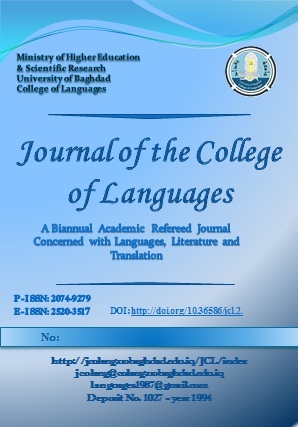Euphemism from a Politeness Perspective: An Exploration of the ability of Iraqi EFL learners to Use and Comprehend Euphemistic Expressions
DOI:
https://doi.org/10.36586/jcl.2.2021.0.43.0118Keywords:
Euphemism, foreign language learning, pragmatics, politeness, interlanguage pragmatics.Abstract
Euphemisms are advantageous in people’s social life by turning sensitive into a more acceptable ones so that resentful feelings and embarrassment can be avoided. This study investigates the ability of Iraqi English learners in using euphemistic expressions, meanwhile, raising their awareness and the faculty members in English teaching faculties regarding the relevance of discussing the topics that demand euphemisation. This study comprised three stages: initial test, explicit instruction with activities, and a final test for the students’ development in this domain. A test has been distributed among 50 respondents, who are at the fourth year of their undergraduate study at the University of Babylon/ College of Basic Education. The low rate of producing and recognising euphemisms in the first stage of the study, it is concluded that Iraqi students that the course design in the foreign context is inadequate. After consistent training during the second stage, students have shown significant development in mastering these expressions.

This work is licensed under a Creative Commons Attribution 4.0 International License.
( Received on 21/6/2020 - Accepted on 11/10/2020 - Published on 2/1/2021 )
References
Al-Husseini, H. (2007). Euphemism in English and Arabic: A Contrastive Study. Retrieved from https://www.researchgate.net/publication/275031614_Euphemism_in_English_and_Arabic_A_Contrastive_Study on the 2nd/January/2018.
Allan, K., & Burridge, K. (1991). Euphemism & dysphemism: Language used as shield and weapon. Oxford University Press, USA.
Allan, K., & Burridge, K. (2006). Forbidden words: Taboo and the censoring of language. Cambridge University Press.
Alotaibi, A. M. (2015). The awareness of euphemism by Kuwaiti speakers of Arabic. International Journal of Linguistics, 7(1), 69-81.
Al-Shamali, F. (1997). Facets of euphemism in Jordan Valley dialect. Unpublished MA Thesis. Yarmouk University.
Ayto, J. (2007). Wobbly bits and other euphemisms (Rev. ed.). London: A. & C. Black.
Brown, H. D. (1989). A practical guide to language learning. New York: McGraw-Hill.
Brown, H. D. (2000). Principles of language learning and teaching (Vol. 4). New York: Longman. Brown, P., & Levinson, S. C. (1987). Politeness: Some universals in language usage (Vol. 4). Cambridge university press.
Bussmann, H. (1998). Phatic communion. Routledge dictionary of language and linguistics, Routledge.
Carnoy, A. J. (1927). La science du mot. Traite de semantique.-Louvain," Universitas" 1927. VIII, 426 S. Louvain, Éditions" Universitas".
Clark, H. H., & Schunk, D. H. (1980). Polite responses to polite requests. Cognition, 8(2), 111-143.
Crystal, D. (Ed.). (2000). The Cambridge encyclopaedia of language (2nd ed.). Cambridge, UK: Cambridge University Press.
Enright, D. J. (1985). Fair of speech: The uses of euphemism. Oxford University Press.
Farghal, M. (1995). Euphemism in Arabic: A Gricean interpretation. Anthropological Linguistics, 366-378.
Genesee, F., & Upshur, J. A. (1996). Classroom-based evaluation in second language education. Cambridge University Press.
Goffman, E. (1955). On face-work: An analysis of ritual elements in social interaction. Psychiatry, 18(3), 213-231.
Goffman, E. (1981). Forms of talk. University of Pennsylvania Press.
Gómez, M. C. (2009). Towards a new approach to the linguistic definition of euphemism. Language Sciences, 31(6), 725-739.
Greene, C.T., 2000. The use of euphemisms and taboo terms by young speakers of Russian and English. Unpublished M.A. Thesis. University of Alberta
Gu, T. Q. (2006). A linguistic Approach to Euphemism. Journal of China West Normal University (Philosophy and Social Sciences Edition), 1, 48-50.
Harris, D. P. (1969). Testing English as a Second Language. New Jersey: McGraw-Hill Book Company.
Heaton, J. B. (1988). Writing English language tests: A practical guide for teachers of English as a second or foreign language. Longman Publishing Group.
Howard, P. (1984). The state of the language: English observed. Hamish Hamilton.
Hugh, R. (1981). A Dictionary of Euphemisms and Other Doubletalk. Michigan: Crown.
Johnson, D. W., & Johnson, R. T. (1988). Critical Thinking Through. Educational leadership, 45, 8.
Jung, J.-Y. (2002). Issues in acquisitional pragmatics. Teachers College-Columbia University Working Papers in TESOL and Applied Linguistics, 2(2), 1-34
Kasper, G. (1992). Pragmatic transfer. Second language research, 8(3), 203-231. doi:10.1177/026765839200800303
Kasper, G. (2001a). Classroom research on interlanguage pragmatics. In G. Kasper & K. R. Rose (Eds.), Pragmatics in language teaching (pp. 33-60). Cambridge: Cambridge University Press.
Kecskes, I. (2014). Intercultural pragmatics. Oxford University Press.
Lado, R. (1961) Language testing: the construction and use of foreign language tests. Longmans Green and Co.: London
Littlewood, I. (Ed.). (1998). Jane Austen: critical assessments (Vol. 1). Psychology Press.
Mackey, A., & Gass, S. M. (2005). Second language research: Methodology and design. Lawrence: Erlbaum.
McArthur, T. B., & McArthur, F. (1992). The Oxford Companion to the English language. Oxford University Press, USA.
McGlone, M. S., & Batchelor, J. A. (2003). Looking out for number one: Euphemism and face. Journal of Communication, 53(2), 251-264.
Mousavi, S. A. (Ed.). (1999). A dictionary of language testing. Rahmana Publications.
Partridge, E. (1947). Euphemisms. Usage and abusage: A guide to good English (pp.131-148). Harmondsworth: Penguin
Qi, G. U. O. (2010). Cultural Differences in Chinese and English Euphemisms. Cross-Cultural Communication, 6(4), 135.
Rabab’ah, G., & Al-Qarni, A. M. (2012). Euphemism in Saudi Arabic and British English. Journal of Pragmatics, 44(6), 730-743.
Rawson, H. (1981). A Dictionary of Euphemisms and Other Doubletalk–Crown Publishers. Inc, NY.
Storr, C. (1985). Euphemisms and children. In Enright, D. J. (Ed.), Fair of speech: The uses of euphemism, 79-91. Oxford: Oxford University Press
Wardhaugh, R. (1986). Introduction to Sociolinguistics. Blackwell: Oxford










